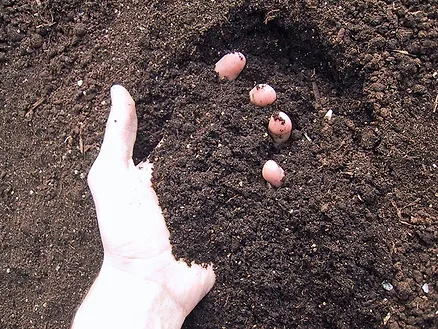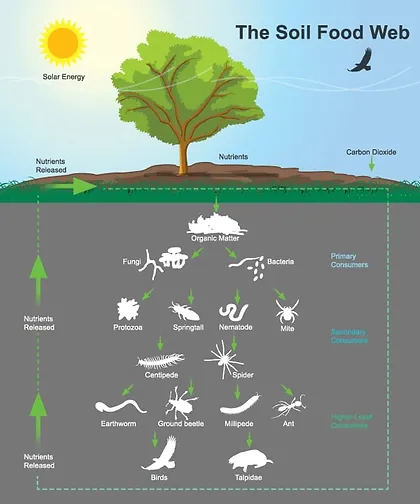Nanette Londeree, Master Rosarian, Marin Rose Society

We gardeners routinely describe fertilizing as “feeding” our plants, but that’s not really accurate. Plants “feed” themselves, producing their own food in the form of sugars through the process of photosynthesis. We add nutrients, chemical elements necessary for plant growth, to supplement those naturally occurring in the soil. Consider how Mother Nature does it in a forest – fallen leaves and dead plants slowly decay; through lots of biological activity, their nutrients go back into the soil and are available to, once again, be taken up by living plants. By fertilizing, we’re doing the same thing – making nutrients available to the plant via the soil. Fertilizing is all about enhancing the soil, in fact, a common definition of the word fertilizer is, a substance used to make a soil more fertile.
What you see going on with your roses above the ground is largely determined by what goes on below your feet; the top four to eight inches of soil is where plants mostly get their nutrients. No matter how much you baby your roses, if the soil isn’t functional and healthy, it won’t matter much. The living component of soil is perhaps the most important to overall plant health. A single spade full of rich garden soil contains more species of organisms than can be found above ground in the entire Amazon rain forest. Commonly referred to as the soil food web, the vast community of organisms live all or part of their lives in the soil. All plants depend on the food web for their nutrition. Managing for soil health is about developing and maintaining a suitable habitat for the many creatures that comprise the soil food web.
BELOW: Hendrikus Organics

Many gardeners fertilize based on the calendar rather than what is actually needed by the plant. Do you know if the nitrogen, phosphorus, and potassium are actually low in your soil? Have you confirmed that magnesium is lacking before adding Epsom salts? You can save yourself time and money by testing your soil with simple test kits; when you know what is deficient, then add just what’s needed. More is not better with many fertilizers; too much of certain elements can result in damage to plants or soil organisms. The next time you’re thinking about fertilizing, consider a few things:
-
What does your soil need? Is it low in all the major elements, nitrogen, phosphorus, and potassium, or just one of these?
-
Will adding the material result in too high a concentration of a given nutrient?
-
Will the material added to soil provide organic matter that is beneficial to the organisms in the soil?
-
Is the material safe for the soil food web, pollinators, or other beneficial creatures?
-
Could the material contaminate groundwater, or result in pollution of watershed through runoff?
Included below are some common materials routinely used to “feed” roses; a few are touted to do great things for our beloved flowers, but is that really true? Read on and you decide:
Alfalfa (Medicago sativa), is an herbaceous perennial plant in the legume family. In addition to low levels of nitrogen, phosphorus, and potassium, it’s rich in protein, vitamins and minerals and breaks down slowly in the soil. It contains triaconatol, a naturally occurring fatty alcohol that is a growth stimulant. It can trigger new basal breaks – that desirable new growth at the bud union or base of the plant, in addition to increasing overall plant vigor and flower production. Be aware that the succulent new growth produced can be an attractant to aphids.
Bone meal is primarily calcium and phosphorus, two elements required for plant growth and that are usually in adequate concentrations in garden soil. Phosphorus, from bone meal or other sources, does not stimulate plant growth or promote flowering; it is only a mineral, not a plant growth regulator. High concentrations of either mineral can be a problem. According the American Rose Society’s (ARS) Consulting Rosarian Manual, symptoms of too little phosphorus: “Older foliage drops without turning yellow. Leaves are dull gray-green in color. Buds slow to develop, leaf edges of older leaves may cup down.” Gardens in high rainfall areas will likely need more potassium and nitrogen, but phosphorus is rarely ever limiting to plant growth in non-agricultural soils.
Epsom salts are the naturally occurring mineral magnesium sulfate. In general, magnesium plays a role in strengthening plant cell walls, allowing the plant to take in the nutrients it needs. The first symptom of a magnesium deficiency in roses is a reduction of leaf size, followed by entire leaves being chlorotic with yellow between veins. The routine addition of Epsom salts can lead to salt accumulation in the soil and create toxic conditions. Roses are not salt-tolerant; symptoms of salt toxicity include leaf tip dieback, marginal leaf chlorosis and necrosis (or burn). In an evaluation of Epsom salts uses in gardening and the often-claimed growth promoting benefits for roses, Linda Chalker-Scott, Ph.D. from Washington State University Extension Service notes “There is no published, scientific research on Epsom salts effects upon roses. The origin of these “research-based” recommendations is unclear.”
Controlled release fertilizers can appear to be a huge benefit to the gardener. They consist of water-soluble fertilizer encased within a polymer coating, forming a round prill. The polymer coating has small holes in which water passes into the prill, solublizes the fertilizer and then the fertilizer slowly leaches from the prill. The rate of the break down and release of nutrients is impacted most by soil moisture and temperature. Moisture is needed to begin the release of controlled release fertilizer. If the soil dries out, it can greatly reduce the amount of fertilizer released.
Multi-purpose products, often marketed as “All in One” or “3 in 1” contain a mixture of fertilizer, insecticide, and fungicide. Using this type of fertilizer product when there is no specific insect pest or disease present adds pesticides to the soil for no purpose, may negatively impact soil organisms, bees and other pollinators, and is much more expensive than single use products.
Remember, Healthy soil = productive healthy roses!




























































